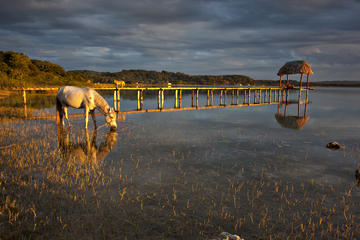
Lake Petén Itza
Guatemala’s second largest lake, a sparkling expanse at the heart of the hot, humid Petén Basin, was one of the earliest cradles of Mesoamerican civilization. The lush rainforests at its fringe are home to at least 27 archaeological sites, in addition to Flores, capital of Petén Department. Once known as Nojpetén (City Island) by the Itza Mayans, Flores was also their regional capital, and was the last Mayan city to fall to the Spanish, in 1697.
You’re probably staying on the island, a great base for enjoying the lake. Head to the north shore for a walk on the malecón, or jump in for a swim with the locals. The west side boasts lakefront restaurants and bars where you can watch the sunset. Hire a cayuco (small, motorized boats) to other attractions overlooking the water, including ruins, Petencito Zoo, Cerro Cahuí Nature Reserve, “El Museo,” a small archaeological museum, and other towns along the lakeshore.
Practical Info
While the vast majority of visitors to Lake Petén Itza stay in Flores, with its wide range of hotels, restaurants, and tour operators, there are other options. The small towns of El Remate, San José, and San Miguel all have basic lodging, more authentic ambiance, and access to their own small ruins, hiking trails, caves, Spanish schools, and other diversions.
Note that inexpensive public boats that once plied the lake have been gradually phased out as roads and bus service improve. Instead, operators offer group boat tours, or you can hire a pricey private cayuco. Budget travelers may want to stick to chicken buses from the Santa Elena market to destinations around the lake.
